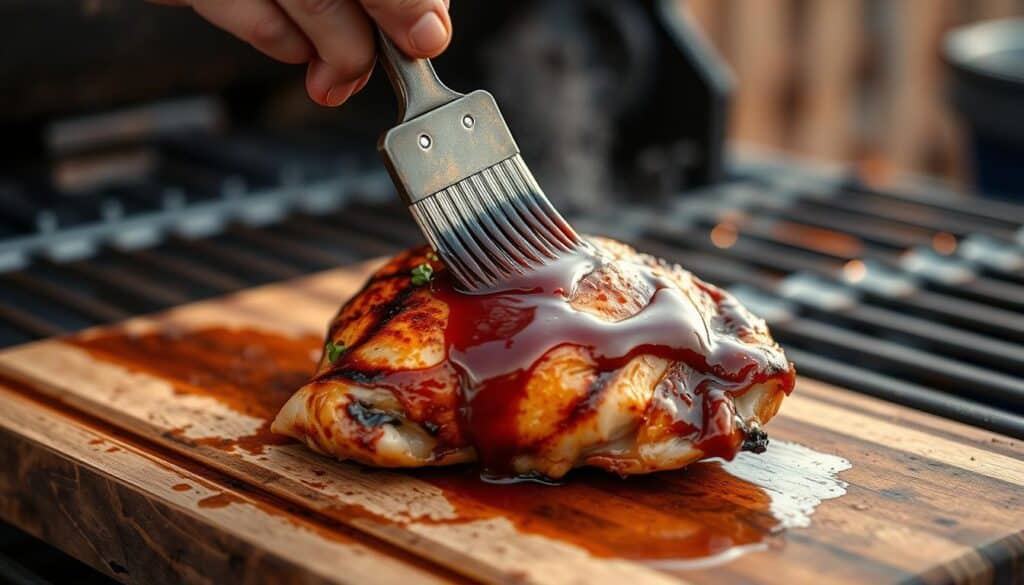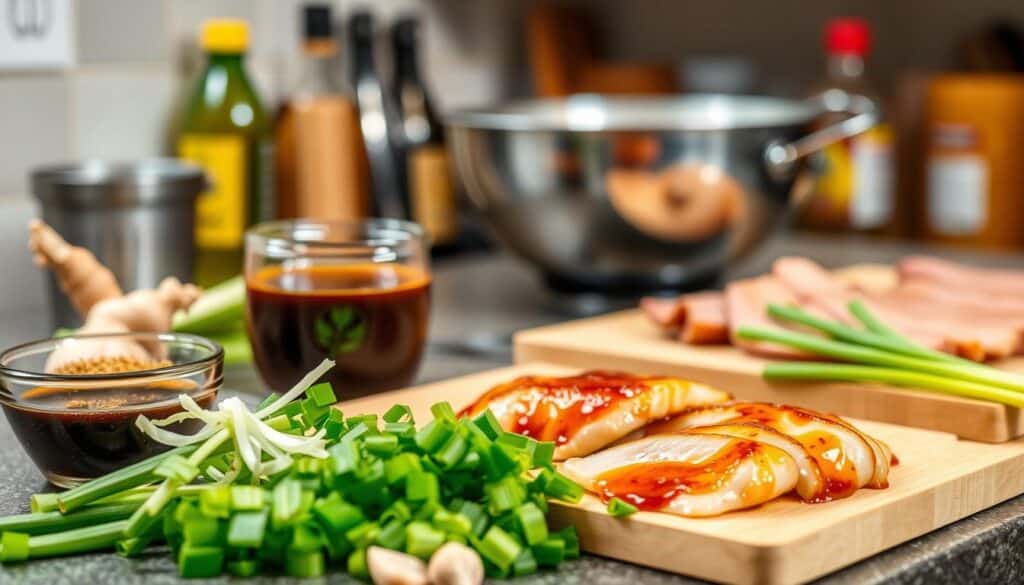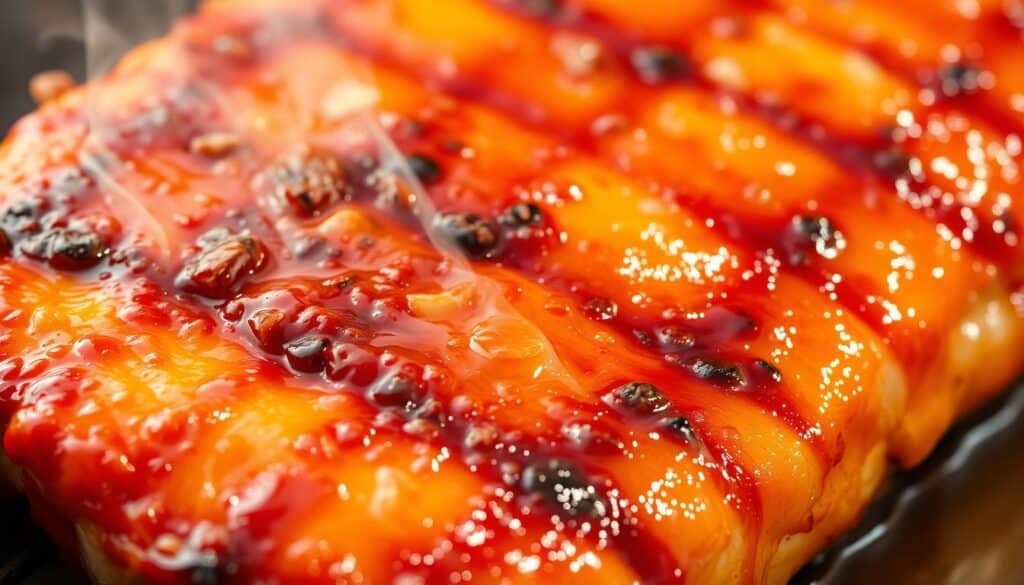There’s something special about the aroma of teriyaki that instantly transports me to a place of comfort and joy. It’s more than just a flavor; it’s a memory, a tradition, and a celebration of simple yet rich ingredients. My journey with teriyaki began in my small kitchen, where I discovered the magic of balancing sweet and savory notes. Today, I’m excited to share this passion with you, inspired by Goat Berry Kitchen’s original recipe and refined by the expertise of Dotdash Meredith Food Studios.
Thank you for reading this post, don't forget to subscribe!This guide isn’t just a recipe; it’s a step-by-step journey to mastering a sauce that’s as versatile as it is delicious. Whether you’re a novice or a seasoned cook, you’ll find that creating homemade teriyaki is surprisingly easy. With just 15 minutes of preparation and cooking, you can elevate your dishes, from chicken to your favorite proteins, with a flavor that’s both familiar and exciting.
So, let’s dive into the world of teriyaki together. By the end of this article, you’ll have a delicious homemade sauce and the confidence to experiment and make it your own. It’s time to savor the flavors and create memories that linger long after the last bite.

Key Takeaways
- Discover the simplicity of making homemade teriyaki sauce in 15 minutes.
- Learn how to balance sweet and savory flavors for a perfect taste.
- Explore various proteins and dishes you can enhance with teriyaki sauce.
- Gain confidence in the kitchen with an easy-to-follow guide.
- Understand the versatility of teriyaki sauce in modern cuisine.
Introduction to Teriyaki Magic
Teriyaki is more than just a flavor—it’s an experience that combines tradition with modern culinary creativity. This section delves into my personal journey with teriyaki, from the first encounter to why it holds a special place in my kitchen.
My First Encounter with Teriyaki
I still remember my first time trying teriyaki. It was like a symphony of flavors on my plate. The way it transformed a simple dish of grilled chicken and rice was nothing short of magical. That moment sparked a curiosity that led me to experiment with this versatile sauce.
What amazed me most was how just a minute of cooking could elevate the dish. The sauce, made with soy as a base, added depth and complexity that I hadn’t experienced before. It wasn’t just about the taste; it was about the memories it helped create.
Why I Love This Flavor
Teriyaki’s balance of saltiness and sweetness is what makes it so irresistible. It’s a perfect blend that can turn any ordinary meal into something extraordinary. Whether it’s a quick weeknight dinner or a special occasion, this sauce always delivers.
One of the things I love most is its versatility. It’s not just for proteins; it can also be used as a dipping sauce or a side to enhance the flavor of your meal. The best part? It’s incredibly easy to make and customize to your taste.
| Cooking Method | Benefits | Suitable Proteins |
|---|---|---|
| Grilling | Smoky flavor, caramelized crust | Chicken, Beef |
| Pan-Frying | Quick cooking, even browning | Pork, Salmon |
| Broiling | Even cooking, less oil | Steak, Tofu |
As I continued to explore, I realized that even a simple recipe could become a full-blown culinary adventure. The key was in the technique and the quality of ingredients. I also learned that teriyaki isn’t just for cooking; it’s also a great marinade, allowing the flavors to seep deep into the meat or vegetables.
What I love most about this sauce is how it brings people together. Whether it’s a family dinner or a gathering with friends, the aroma of teriyaki always seems to create a sense of warmth and togetherness. It’s more than just a flavor; it’s a way to connect and share in the joy of food.
For those looking to dive deeper into the world of teriyaki, I recommend checking out its rich history and how it has evolved over time. Understanding its origins only adds to the appreciation of this culinary gem.
Essential Ingredients for an Authentic Teriyaki Experience
Creating a delicious teriyaki dish starts with the right ingredients. A few key components make this sauce so special, and they balance the flavors.
Key Components and Their Roles
The foundation of a great teriyaki sauce is water and soy sauce. Water perfectly thins the sauce, while soy sauce adds depth and saltiness. A tablespoon of honey or brown sugar brings just the right amount of sweetness. I like adding a teaspoon of grated ginger and a pinch of garlic powder for an extra layer of flavor.
Ingredient Alternatives and Substitutions
Mirin adds a subtle sweetness, but you can substitute it with a mix of rice vinegar and sugar if needed. Cornstarch is essential for thickening the sauce; mix 1 tablespoon of cornstarch with 2 tablespoons of water for the perfect glaze. For a lighter option, you can reduce the amount of sugar or use honey instead.
| Component | Role | Substitution |
|---|---|---|
| Water | Thins the sauce | None needed |
| Soy Sauce | Adds saltiness | Low-sodium option |
| Honey/Brown Sugar | Provides sweetness | Mirin or rice vinegar |
| Ginger | Enhances flavor | Garlic powder |
| Cornstarch | Thickens sauce | Flour (double amount) |

With these ingredients, you can create a sauce that elevates any dish. Whether you’re cooking chicken or tofu, the right balance of flavors will make your meal unforgettable.
Step-by-Step Guide to Making Homemade Teriyaki Sauce
Creating your own homemade teriyaki sauce is simpler than you might think. You can craft a delicious glaze that elevates any dish with just a few ingredients and some basic cooking techniques. Let’s break it down into easy-to-follow steps.
Gathering Fresh Ingredients
Start by collecting all your ingredients. You’ll need a cup of soy sauce, a quarter cup of brown sugar, minced garlic, and fresh ginger. These form the foundation of your sauce. To thicken it, prepare a slurry with a tablespoon of cornstarch and two tablespoons of water.
Mixing and Heating the Sauce
Combine soy sauce, brown sugar, garlic, and ginger in a pan over medium heat. Stir well to infuse the flavors. Bring the mixture to a simmer, reducing it slightly for about five minutes. This step enhances the flavor profile, creating a rich glaze.
Thickening and Finishing Touches
Gradually stir in the cornstarch slurry to thicken the sauce. Continue stirring for another two to three minutes until it reaches your desired consistency. Remove from heat and let it cool slightly before using or storing.
Serving Suggestions
Your homemade teriyaki sauce is versatile. During the last few minutes of cooking, use it as a glaze for proteins like chicken or tofu. It also makes a great dipping sauce. For inspiration, check out this homemade teriyaki sauce recipe or how to use it in chicken dishes.
With these steps, you’ll have a delicious homemade teriyaki sauce ready to enhance your meals. Enjoy the satisfaction of cooking with your own creation!
Mastering Teriyaki: Grilled meat or fish coated in a sweet and savory teriyaki sauce.
Grilling is where the magic truly happens, transforming simple ingredients into a culinary masterpiece. The right techniques and ingredients can elevate your dish, delighting every bite.
Choosing the Perfect Protein
Selecting the right protein is crucial. Fish like salmon, with its rich flavor, or meats like flank steak, known for its texture, are excellent choices. These options absorb the marinade beautifully, ensuring a balanced taste.
Grilling Techniques and Tips
Temperature control is key. Preheat your grill to medium-high heat and brush it with oil to prevent sticking. A marinade with sake and honey enhances flavor. For a perfect char, sear the protein for 3-4 minutes per side, then finish at a lower heat to keep it juicy.
| Protein | Benefits | Cuts |
|---|---|---|
| Fish (Salmon) | Rich flavor, moist texture | Steaks or fillets |
| Beef | Tender, caramelized crust | Flank steak, sirloin |

For crispy fish, try this fish fry mix. Adjusting oil and brown sugar levels can make your dish extraordinary. Happy grilling!
Tips, Variations, and Common Pitfalls
Perfecting your dish requires more than just the right ingredients—it’s about mastering the techniques and avoiding common mistakes. Whether you’re a novice or an experienced cook, these tips will help refine your skills and make your creations stand out.
Exploring Recipe Variations
One of the joys of cooking is experimentation. Try adding sesame seeds or adjusting the sugar levels to suit your taste for a unique twist. These small tweaks can make a big difference in the final serving. I’ve found that a pinch of red pepper flakes can add a delightful kick, while a drizzle of fresh lime juice can brighten the flavors.
Troubleshooting Common Mistakes
We’ve all been there—too thin, too thick, or just not right. If your sauce turns out bitter, it might be due to over-reduction. Start fresh with a smaller batch and adjust as you go. Cornstarch is your best friend for consistency issues. Mix it with a little water before adding it to the sauce to avoid clumps. Remember, medium heat is key to achieving that perfect glaze without burning.
| Common Issue | Solution |
|---|---|
| Bitter Taste | Adjust sugar levels or start with a smaller batch |
| Too Thin | Simmer longer or add a little cornstarch slurry |
| Too Thick | Stir in a bit more water or broth |
When grilling, ensure your protein is cooked evenly. Whether it’s chicken, beef, or tofu, the right technique makes all the difference. Test your skills with different proteins to find your favorites. With these tips, you’ll be well on your way to creating dishes that impress every time!
Conclusion
Reflecting on my journey with this delicious condiment, I’m reminded of how simple it is to create something extraordinary. From the initial discovery to mastering the perfect mixture, every step has been a delightful learning experience.
The key to a great dish lies in balanced ingredients and careful grilling. Whether you’re using it as a marinade or a finishing touch, the result is nothing short of magical. I encourage you to experiment with different proteins and flavors to make each meal unique.
Even if you’re new to cooking, following these instructions will help you craft an authentic experience. Feel free to revisit this guide for clarification and share your successes—or challenges—in the comments below.
So go ahead, embrace this new way of cooking, and enjoy creating delicious grilled dishes with a rich, flavorful condiment. Happy cooking!
FAQ
How long does homemade teriyaki sauce last in the fridge?
Homemade teriyaki sauce can be stored in the fridge for 2 weeks. To maintain freshness, keep it in an airtight container.
Can I use honey instead of sugar for a healthier option?
Yes, you can use honey as a substitute for sugar. Start with 1 tablespoon of honey and adjust to taste, as honey can be sweeter than sugar.
What if I don’t have mirin? Are there good substitutes?
If you don’t have mirin, you can mix 1 tablespoon of sugar with 1 tablespoon of water as a substitute. This will give you a similar sweetness without the same depth of flavor.
How do I prevent the sauce from burning when cooking?
Stir the sauce constantly over medium heat, avoiding high heat. If it starts to thicken too quickly, adding a little water can also help thin it out.
Can I use this sauce for other proteins besides chicken?
Absolutely! This teriyaki sauce works well with fish, tofu, or even as a dipping sauce for appetizers. Feel free to experiment with different proteins.
How much sauce should I use for one serving?
A good rule of thumb is to use about 1/4 cup of sauce per serving. You can always add more, but it’s easier to start with a smaller amount and adjust to taste.
Can I make this sauce ahead of time for a party?
Yes, you can make the sauce up to 2 days in advance. Store it in the fridge and give it a quick stir before using it for your event.
What’s the best way to thicken the sauce if it’s too runny?
Mix 1 teaspoon of cornstarch with 2 tablespoons of water until smooth. Stir this mixture into the sauce and cook for another minute to thicken.
Can I use this sauce as a marinade?
Yes, you can use this sauce as a marinade for chicken or fish. Marinate for at least 30 minutes to an hour before cooking for the best flavor.
How do I achieve a good glaze when cooking?
Brush the sauce onto your protein during the last few minutes of cooking. This will help create a nice glaze without burning the sauce.
Can I reduce the sodium content of the sauce?
You can reduce sodium by using low-sodium soy sauce or tamari. Start with a small amount and taste as you adjust the seasoning.
What’s the best oil to use for cooking?
Neutral oils, such as vegetable or canola oil, work well for cooking with teriyaki sauce. They have a high smoke point and will not affect the flavor of the dish.
Can I add garlic and ginger to the sauce for extra flavor?
Absolutely! Mince 1 clove of garlic and 1 teaspoon of fresh ginger, and sauté them in a little oil before adding the sauce for added depth of flavor.
How do I know when the sauce is ready?
The sauce is ready when it thickens slightly and coats the back of a spoon. This usually takes about 5-7 minutes of simmering.
Can I serve this sauce with rice?
Yes, teriyaki sauce pairs perfectly with a side of rice. It’s a classic combination that balances the flavors of the dish.
What’s the best way to store leftover sauce?
Let the sauce cool completely, then transfer it to an airtight container. You can store it in the fridge for up to 2 weeks or freeze it for up to 3 months.
Can I use this sauce for stir-fries?
Yes, this teriyaki sauce is great for stir-fries. Add it towards the end of cooking to avoid it becoming too thick.
How do I avoid overpowering the dish with too much sauce?
Start with a small amount of sauce and taste as you go. You can always add more, but it’s harder to remove excess sauce once it’s added.
Can I make this sauce gluten-free?
You can make this sauce gluten-free by using gluten-free soy sauce or tamari. Ensure all other ingredients are also gluten-free.
What’s the best way to reheat leftover sauce?
Reheat the sauce gently over low heat, stirring occasionally, until it reaches your desired temperature. Avoid boiling, as it can thicken too much.
Can I use this sauce as a dip?
Yes, this sauce makes a great dip for appetizers like dumplings or tempura. For the best experience, serve it chilled or at room temperature.
How do I know if the sauce has gone bad?
If the sauce develops an off smell, slimy texture, or mold, it has gone bad and should be discarded immediately.
There are no reviews yet. Be the first one to write one.

